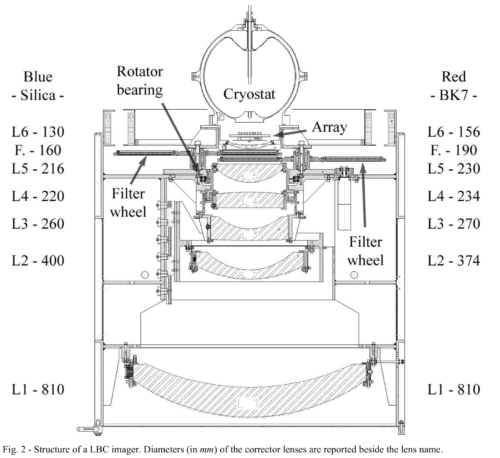Rotator
The LBC cryostats and filter wheels are mounted on the rotator flange, which rotates at the rate of change of the parallactic angle to compensate for field rotation.

Figure: In the drawing at left (from Speziali et al 2008, SPIE Vol 7014), the rotator bearing is indicated along with the filter wheels, cryostat and the lenses, labeled L1 through L6. L6 is also the dewar window. The cryostat and filter wheels are all mounted to the rotator and are decoupled from the lenses L1-L5.
Several considerations important for observing with and reducing data from the LBCs:
- The rotator can move up to 4 degrees per second and, thus, can track field rotation up to 89.5 degrees elevation (from the commissioning reports, though actually 4 deg/sec is good for up to 89.95 deg elevation, right?; opk), however inaccuracies in pointing effectively limit observations to below ~86 degrees. We recommend that you correct pointing and copointing before starting an exposure at high elevation (~80 deg), even if you have already corrected pointing and copointing on this field earlier.
- The rotator trajectory is based on the assumption that the telescope pointing and copointing are accurate. If they are not, then the field rotation will not be perfectly countered and the stars will trace out arcs of radius equal to the error in the pointing. If guiding, the arcs traced by the stars closest to the guide chip (tech chip #1 on the right side of the field) will be almost “guided out”, but stars on the left side, far from the guide chip, will be trailed.
- The rotator receives the rotator trajectory, a list of (theta, dtheta) pairs, from the telescope control system. It has no time reference and starts to act on this list at a time that is calculated given the system overheads. This has generally worked well, however the orientation of the field on the detector can vary by as much as ~0.5 deg from image to image (particularly on the first image as compared to the remaining ones in the script).

